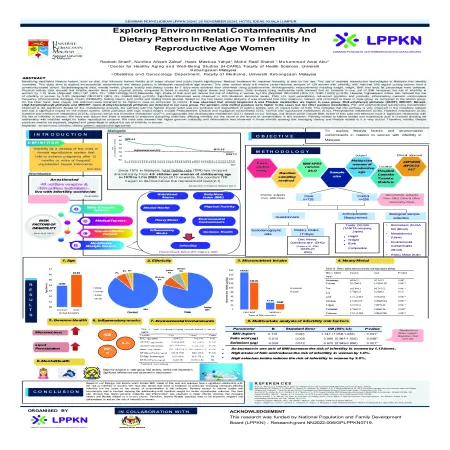|
Exploring environmental contaminants and dietary pattern in relation to infertility in reproductive age women
|
|
: 144016 Views : |
| Item type | Scientific Poster |
| Subjects | 600 Technology > 607 Education, research & related topics |
| Division/Agency | LPPKN - National Population and Family Development Board, Malaysia: Population and Family Research Division |
| Keywords | Reproductive health, Infertility |
| Additional Information | This poster have been presented at Seminar Penyelidikan LPPKN 2024, November 25, 2024 in IDEAS Hotel Kuala Lumpur. |
| Abstract | Identifying modifiable lifestyle factors, such as diet, that influence human fertility is of major clinical and public health significance. Medical treatment for impaired fecundity is also on the rise. The use of assisted reproductive technologies in Malaysia has steadily increased. This study aims to explore environmental contaminants and dietary pattern in Malaysian reproductive age women. This case control study will involve cross-sectional analysis of 128 women with infertility, with matched 256 regular cycling women from a community-based cohort. Sociodemographic data, mental health, physical activity and dietary intake for 7 days were obtained from interviews using questionnaires. Anthropometric measurements including weight, height, BMI, and body fat percentage were collected. Physical activity data showed that infertile women have lower physical activity compared to those in control and higher stress and depression. Data analysis using multivariate tests showed that an increase in one unit of BMI increased the risk of infertility in women by 1.15 times [Adjusted OR=1.147 (95% CI= 1.059-1.243)])(p<0.01).Meanwhile, high intake of folic acid will reduce the risk of infertility in women by1.0% [Adjusted OR=0.990 (95% CI= 0.981-1.000)] (p<0.05). Likewise, highselenium intake also reduced the risk of infertility in women by 3.0% [Adjusted OR=0.972 (95% CI= 0.949-0.996)] (p<0.05). Significant differences were observed in Anti Mullerian Hormone levels, FSH, LH, lipid peroxidation, advanced glycation end products, inflammatory markers, micronucleus frequency (chromosomal damage), insulin (HOMA-IR), fasting insulin, lipid profile and fasting blood glucose. Based on the hair heavy metal analysis, it was observed that zinc, selenium, calcium and chromium is lower in case group as compared to the control group. On the other hand, lead, copper and cadmium were observed to be higher in case as compared to control. It was observed that urinary bisphenol A and Phtalate metabolites are higher in case group. Di-(2-ethylhexyl) phthalate (DHEP), MEHHP, Mono (2-ethyl-5-hydroxyhexyl) phthalate and MEOHP, mono (2-ethyl-5-oxohexyl) phthalate are detected in our case group. For paraben, only methyl paraben were higher in the cases but not other paraben metabolites. Per- and polyfluorinated substances) concentration observed is not significant. Based on the metabolomic analysis, the pathway with the highest impact factor was the synthesis and degradation of ketone bodies, with an impact factor of 0.60. This indicates that this pathway is very important in the metabolic network and has a significant impact on the overall system. Other pathways with high impact factors include Phenylalanine, tyrosine and tryptophan biosynthesis (0.5), Taurine and hypotaurine metabolism (0.42), Phenylalanine metabolism (0.35), Histidine metabolism (0.32), Cysteine and methionine metabolism (0.274), Glycine, serine and threonine metabolism (0.271), and glyoxylate and dicarboxylate metabolism (0.21). Based on our findings, risk factors which include BMI, intake of folic acid and selenium have a significant relationship with the risk of infertility in women. We have also shown that there is existence of endocrine disrupting chemicals affecting infertility but the cause or the source of contamination is still unknown. Pathway related to ketone bodies and tricarboxylic acid is involved showing the relationship with healthier weight for better reproductive outcome. We have also showed that higher genomic instability and inflammation was observed in those infertile showing that managing dietary and lifestyle related to it is very crucial. Therefore, healthy lifestyle practices need to be improved, targeted and personalized to reduce the risk of infertility in women. |











